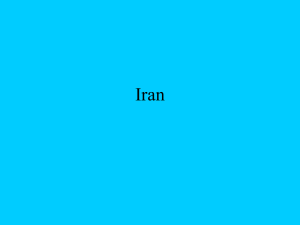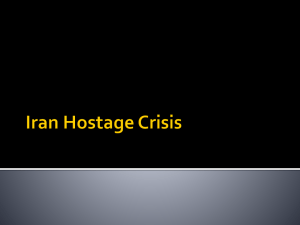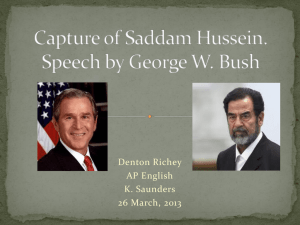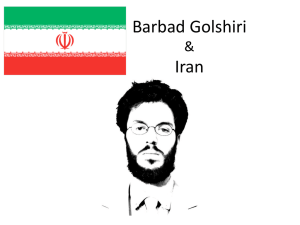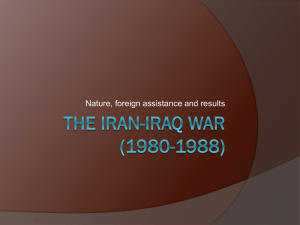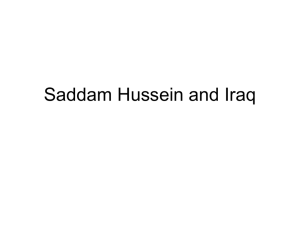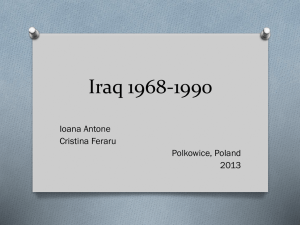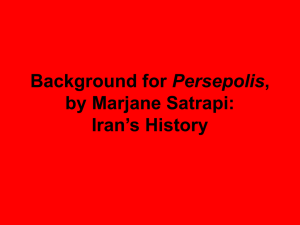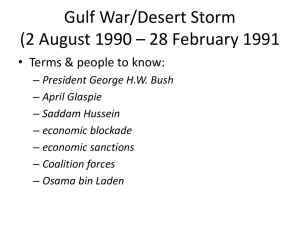The Iran-Iraq War causes
advertisement
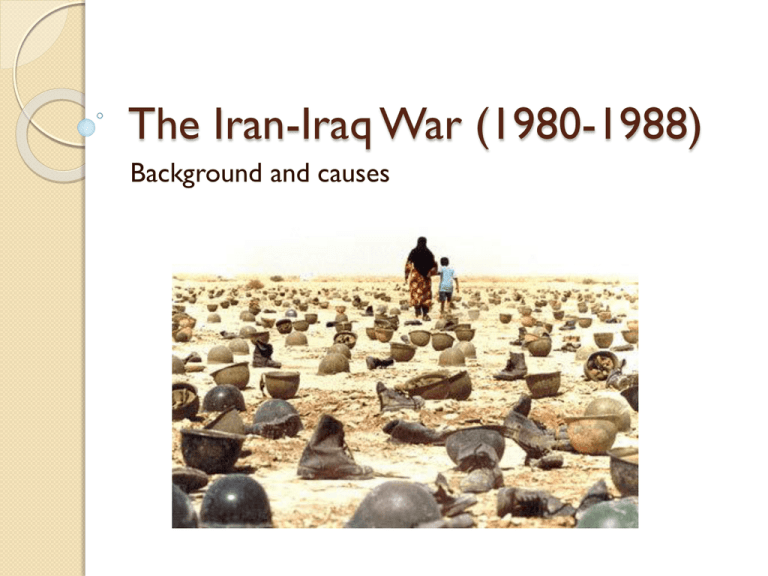
The Iran-Iraq War (1980-1988) Background and causes Context 1979: Egypt-Israel Peace Treaty 1979: Iranian Revolution 1980: Soviet invasion of Afghanistan 1982: Israeli intervention in the Lebanese Civil War Iran Originally the Persian Empire Predominantly Shiite Muslim Ruled by Shah (king) Mohammad Reza Pahlavi (1941-79) Close ally of the US until the Iranian Revolution Iranian Revolution (1979) The Shah’s policies became unpopular: ◦ “White Revolution in 1963” favoured wealthy classes ◦ Heavy reliance on US support ◦ Efforts to secularise Iran ◦ Corruption Religious leader Ayatollah Khomeini became a political figure after being exiled by the Shah in 1963 Khomeini successfully spread his political ideology and united opposition groups against the Shah whilst in exile Demonstrations against the Shah begin in 1977 Climax in December 1978; over 10% of Iranians demonstrate against the Shah The Shah is forced to abandon his position in 1979 Iraq Formerly part of the Ottoman Empire British mandate until 1932 Arab identity; culturally different from the Persians 3 distinct demographic blocs ◦ Sunni Muslims (held majority in the government) ◦ Shiite Muslims ◦ Kurdish minority Rise of Saddam Hussein The Hashemite monarchy is overthrown in a military coup in July 1958 The coup was inspired by the panArabism movement by Nasser and was discontent with Britain’s heavy influence in Iraq Another coup in 1963 established the Arab Socialist Baath Party in Iraq. Saddam Hussein was the Party Secretary at this time. The Baathists formerly seized power in a bloodless coup in 1968. Saddam Hussein is named President Al-Bakr’s Deputy. Saddam continued to build his power base, forcing Al-Bakr to resign in 1979 Shatt al-Arab conflict The Shatt al-Arab waterway laid at the Iran-Iraq border and was the confluence of many rivers that ran through both Iran and Iraq Economic importance: The waterway was essential to connect Iraqi and Iranian cities/oilfields to the Gulf The waterway was critical for Iraq as it had a limited access to the Gulf The ambiguous border and Iranian support for the Kurds in Iraq led to open conflict in 1974 The conflict was resolved by the 1975 Algiers Agreement. Iraq agreed to divide the Shatt alArab equally in return for peace with Iran. CAUSES Sunni-Shia divide Early historians of the Iran-Iraq War contend that the traditional divide between Sunni and Shiite sects contributed to the outbreak of war The adoption of Shia Islam as the official state religion in Persia during the 16th century caused territorial fragmentation in the Islamic World. Whilst Ottoman rulers sought to re-establish Islamic unity, Persia, under Shah Ismail I, sought to separate itself from the Sunni faith. The divide caused intense rivalry Khomeini’s Iranian Revolution can be compared with Shah Ismail’s doctrine, since both advocated Shia teachings and traditions, and undermined the separation of religion and state. Essentially the war was a re-emergence of this divide Results of the Iranian Revolution Ayatollah Khomeini seizes power as the Supreme Leader of Iran. Under Khomeini, an aggressive and xenophobic Shiite theocracy is set up. Khomeini needed a distraction from domestic troubles: ◦ Economic problems inherited from the Shah’s rule ◦ Many who had supported the overthrow of the Shah now mounted in opposition of Khomeini Iran began to openly denounce the Iraqi Government, supporting Iraqi opposition groups and engaging in border skirmishes Saddam Hussein saw this as a violation of the 1975 Algiers Agreement Results of the Iranian Revolution Khomeini advocated to “export the Revolution”. This threatened Iraq, since many Shiite communities in Iraq were underdeveloped and discriminated against. Iraqi fears of a Shiite rebellion was one of the motivations of Iraq’s invasion of Iran in 1980 Iraqi ambitions Saddam Hussein wanted to “restore Iraqi-Arab identity” in the region Saddam wanted to gain full sovereignty of the Shatt al-Arab Khuzestan in the southwest of Iran became an important ploy in Saddam’s rhetoric: ◦ Called “Arabistan” during an autonomous period in the Persian Empire ◦ It had a predominantly Arab population ◦ It was an oil rich region Saddam also wanted control of oil rich islands in the Straits of Hormuz These factors motivated Iraq to invade Iran Ideological conflict After Egypt’s expulsion from the Arab League in 1979, a power vacuum emerged in the Middle East. Iraq hoped to become the new leader of the Arab world. Pan-Arabism became a strong part of Saddam’s rhetoric. Iran adopted a slightly different doctrine of “pan-Islamism”. However, the ideal was skewed, implying the unification of Muslims under the Shia sect. These two doctrines both contested for leadership of the Middle East Clash of personalities The egocentric personalities and dogmatic attitudes of Saddam and Khomeini, contributed to the outbreak of war The fiery rhetoric on both sides intimidated the other: ◦ Saddam was called a despotic criminal of the Iraqi Shiites ◦ Similar insulting remarks were made about Khomeini The exaggerated rhetoric misrepresented the concerns of both countries Khomeini intentionally did this to quell domestic strife Saddam intentionally did this to establish his position in the Arab world Foreign influence An arms race was caused by foreign influence in the region cause by Cold War rivalries ◦ US support of Iran during the Shah’s rule ◦ British support of the Iraqi monarchy ◦ Soviet support of the Iraqi Republic (before Saddam) The result was a significant stockpile of arms on both sides before the outbreak of the war The spark Iran and Iraq engaged in tit-for-tat diplomacy due to the border skirmishes Attempted assassination attempt of Iraqi Deputy Prime Minister Tariq Aziz is blamed on Iran Iraq invades Iran on 22 September 1980 HISTORIOGRAPHY Majid Khadduri Iraqi-born historian Former Iraqi UN delegate Book: The Gulf War: the Origins and Implications of the Iraq-Iran Conflict. Argues that: ◦ The origin of the conflict lies in the Sunni-Shia divide ◦ Iran disrespected the Algiers Agreement which represented peace between the two nations ◦ Iraq did it’s best to seek peace regarding border issues after the Iranian Revolution ◦ The invasion was a justified pre-emptive measure Behrouz Souresrafil Exiled Iranian journalist Book: The Iran-Iraq War Argues that: ◦ Centuries of cultural differences does not cause wars ◦ Iran-Iraq War a direct result of the Iranian Revolution ◦ Iraq feared a Shiite rebellion ◦ Also contends that a clash of personalities had a part to play Daniel Pipes American historian A conservative political commentator who is highly critical of Islamic Terrorism Book: A Border Adrift: Origins of the Conflict. Argues that: ◦ Many observers over-attributed cultural antagonisms as a cause of the war, due to the surprising nature of the Iranian Revolution ◦ In the sixteenth century, although at war, Ottoman sultan wrote literature in Persian, whilst Shah Ismail wrote in Turkic, highlighting minimal cultural tension ◦ Iraq launched the war to wrest full control of the Shatt alArab waterway and gain the prestige of victory ◦ Iraq didn’t launch war over fear of a Shia rebellion. There were no major problems with Shia groups in Iraq
